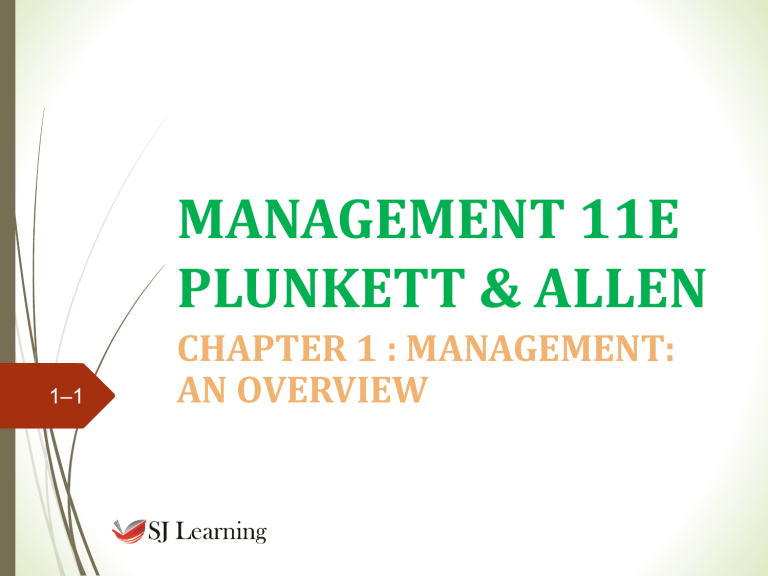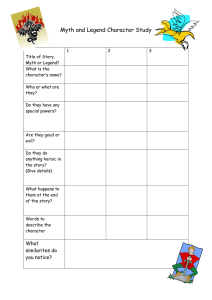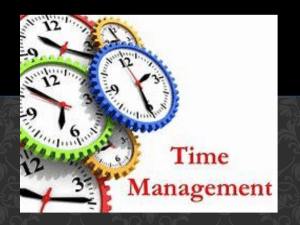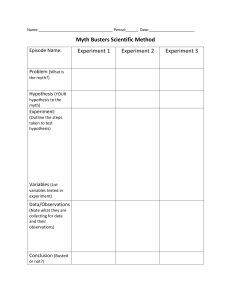
MANAGEMENT 11E PLUNKETT & ALLEN 1–1 CHAPTER 1 : MANAGEMENT: AN OVERVIEW 1–2 Learning Outcomes After reading and studying this chapter, you should be able to: 1. Explain why organizations need managers 2. Outline factors that affect a manager’s universe 3. Identify three levels of management 4. Describe five management functions 5. Apply management functions to each level of management 6. Summarize ten management roles 1–3 Learning Outcomes (cont’d) After reading and studying this chapter, you should be able to: 7. Analyze three management skills 8. Contrast the myths with the realities of a manager’s job 9. Discuss the criteria used to evaluate a manager’s performance 1–4 Management and Managers Managers People who allocate and oversee the use of resources Management One or more managers individually and collectively setting and achieving goals by exercising related functions and coordinating various resources 1–5 Management and Managers (cont’d) Goal An outcome to be achieved or a destination to be reached over a period of time through the exercise of management functions and the expenditure of resources Objective A short term goal that is achieved in less than a year Specific Measurable Attainable Results-oriented Time-limited 1–6 Organizational Need for Managers Organization An entity managed by one or more persons to achieve stated goals Basic Tasks of Management (Drucker) Running a business Building an organization Coordinating activities while accepting the values and goals of the organization Values constitute beliefs and basic tenets that are important and meaningful to those individuals and organizations that hold them. 1–7 The Manager’s Universe Constant change in business requires that managers and organizations meet needs for: Pleasing customers Improving products and services continuously Providing leadership Acting ethically Valuing diversity in their employees Learning to cope with global challenges 1–8 The Need to Please Customers Quality The features and characteristics of a product or service that allow it to satisfy requirements of those who use or consume them Customer Any person or group, both inside and outside an organization, who uses or consumes outputs from an organization or its members 1–9 The Need to Please Customers (cont’d) Website Company’s lifeline to its customers. Web 2.0 Refers to blogs, wikis, and social networking Customer Relationship Management Long-term management approach to customer relationships which attempts to strengthen ties between the customer and the organization 1–10 What Is Web 2.0? 1–11 The Need to Provide Leadership Leadership The ability to get people to follow voluntarily Leaders Develop and articulate the organization’s goals Initiate and facilitate change by exhibiting sets of values, skills, abilities, and traits that are needed by and are an inspiration to others. Create and maintain supportive environments in which employees can figure out what needs to be done Must be present at every level in the organization 1–12 The Need to Act Ethically Ethics The branch of philosophy concerned with what constitutes right and wrong human conduct, including values and actions, in a given set of circumstances Personal Ethics Experiences create a moral code of values and attitudes—conscience Managers cannot be leaders without a strong set of moral and ethical values and a commitment to avoid compromising them. 1–13 The Need to Value Diversity Differing Age Groups Mental and Physical Capabilities Cultural and National Origins Sources of Diversity Genders Ethnic and Racial Backgrounds 1–14 The Need to Value Diversity (cont’d) Challenges for Managers 1. Integrating the diversity that exists in their communities and external customers into their work forces 2. Learning about and understanding their employees’ differences 3. Finding ways to utilize and celebrate these differences 1–15 The Need to Cope with Global Challenges Technological Advances Social and Political Changes Crises and Terrorism Global Challenges Economic Changes Natural Disasters 1–16 Levels of Management Top Management The chief executive officer (CEO) and/or president and his, her, or their immediate subordinates, usually called vice presidents Middle Management Includes managers below the rank of vice president but above the supervisory level First-Line Management Supervisors, team leaders, and team facilitators who oversee the work of nonmanagement people (e.g., operative employees) Functional Managers Managers whose expertise lies primarily in one or another of the specialty areas—marketing, operations, finance, and human resources 1–17 Figure 1.1 Levels of the management hierarchy 1–18 Figure 1.2 Typical titles in the three levels of management 1–19 Management Functions Planning Controlling Organizing Management Leading Staffing 1–20 Management Functions Planning Foundation for the other functions Identify goals and ways to achieve them Assign priorities to each goal Determine the resources required Determine actions that commit: individuals departments entire organization 1–21 Planning Considerations External and Internal Influences on Planning Duration and Scope of Planning Planning Flexibility in Planning 1–22 Management Functions (cont’d) Organizing Creates a structure in meeting goals by: Determining the tasks to be accomplished Grouping these tasks by employee position Deciding on the relationships the positions have to one another 1–23 Management Functions (cont’d) Staffing Execute HR management activities: Determine skills and experiences of each position Determine number of persons needed Train employees for positions Leading Help organization and employees achieve goals Serve as role models for expected behaviors Coach, counsel, inspire, and encourage Communicate and listen Respond to concerns and resolve disputes 1–24 Management Functions (cont’d) Controlling Mechanism to ensure things go according to plan Prevent, identify, and correct deviations from guidelines Identify and correct the causes of deviations 1–25 Figure 1.3 Relative emphasis on each management function at different management levels 1–26 Figure 1.4 Mintzberg’s ten management roles Figurehead Leader Liaison INTERPERSONAL Performs symbolic duties Motivates subordinates Maintains network of contacts Monitor Disseminator Spokesperson INFORMATIONAL Seeks and receives variety of special information Transmits information received to others Transmits to outsiders information about organization Entrepreneur Disturbance Handler Resource Allocator Negotiator DECISIONAL Searches organization and environment for opportunities Initiates corrective action Fulfills responsibility for allocation of organizational resources Represents the organization in major negotiations Source: Chart from The Nature of Managerial Work, by Henry Mintzberg. Copyright © 1973 by Henry Mintzberg. Reprinted by permission of the author. 1–27 Figure 1.5 Conflicting role demands on a manager 1–28 Management Skills Technical Skills Human Skills Conceptual Skills The abilities to use the processes, practices, techniques, and tools of the specialty area a manager supervises The abilities to interact and communicate successfully with other persons The mental capacity to conceive and manipulate ideas and abstract relationships 1–29 Figure 1.6 Proportions of management skills needed by management level 1–30 Management Myths and Realities Myth #1. Managers are reflective, methodical planners with time to systematically plan and work through a day. Myth #2. Effective managers have no regular duties to perform. They establish others’ responsibilities in advance and then relax to watch others do the work. Myth #3. The manager’s job is a science; managers work systematically and analytically to determine programs and procedures. Myth #4. “Managers are self-starting, self-directing, and autonomous, or they would not be managers.” Myth #5. “Good managers seek out the information they need.” Myth #6. “Competition among managers is good for . . . business.” 1–31 Evaluating a Manager’s Performance Managers are evaluated by: How effectively they play the three sets of management roles Whether they possess and properly apply management skills How effective they are in setting objectives and achieving goals How efficiently they use their talents and resources How well they demonstrate leadership Whether they act ethically How effectively they make use of the diversity of their people How effectively they and their people please customers 1–32 Why Managers Fail Uncertainty about the boss’s expectations Lack of political savvy Inability to build relationships Reasons for Failure Inability to make tough decisions Taking too long to learn the job 1–33 Key Terms conceptual skills customer customer relationship management (CRM) diversity ethics first-line management functional managers goal human skills Leadership management management hierarchy manager middle management organization quality role technical skills technology top management Web 2.0






